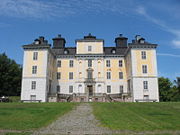- Norwegian police troops in Sweden during World War II
-
The Norwegian police troops in Sweden during World War II consisted of around 13,000 troops, recruited from Norwegian refugees and trained at a number of secret camps in Sweden.[1][2]
Contents
Background
During the occupation of Norway by Nazi Germany many Norwegians fled to Sweden to escape from the occupiers. Nearly 50,000 registered refugees arrived in Sweden during the war years.[3] In 1942 head of the Swedish National Laboratory of Forensic Science, Harry Söderman, made a visit to London, where he met the exiled Norwegian Minister of Justice Terje Wold. Wold asked Söderman about the possibilities for educating Norwegian policemen in Sweden. Söderman himself was positive, but due to Sweden's neutrality policy such a task was not possible in 1942. In February 1943, when the number of Norwegian refugees had steadily increased, there was a contact between Söderman and Olav Svendsen, head of the legal office at the Norwegian legation in Stockholm, and the two then agreed on a plan to start a course for education of fifty Norwegian policemen. These policemen should support the expected legal investigations needed after the war. Svendsen was responsible for getting funding from the Norwegian exile government in London, while Söderman got a go from the Swedish Minister of Social Affairs Gustav Möller.[4]
The first courses
The first course for 20 policemen started in Stockholm 1 July 1943, and further courses were held over time. The goal was to educate policemen who could participate in the legal purge in Norway after the war. Another course was held at the manor Johannesberg, north of Stockholm, for education of uniformed police. Around 1,500 men were educated here, and their education included use of weapons and military training.[5] Among the driving forces in the planning phase were, in addition to Söderman, surgeon Carl Semb, who had organized "health camps" were the refugees were classified, and Ole Berg, military attaché at the Norwegian legation.[6] Funding and other details were discussed by the Norwegian government-in-exile in London.[7]
The Swedish Government was not officially informed of the plans for education of Norwegian police troops until 2 November 1943, although Minister Möller had been involved in the preparations.[8] On 3 December 1943 the Swedish Government officially allowed the education of 8,000 reserve troops and 1,500 ordinary police troops. The education should take place in separate camps, and the maximum number of troops in each camp was limited to 500, excluding administration and catering staff. Shooting practice was allowed in four camps, and weapons should be available for one third of the troops. The duration of the education was limited to three months. Harry Söderman was appointed as responsible for the education of Norwegian police troops.[9][10][11]
Camps
 Mälsåker Castle in 2007
Mälsåker Castle in 2007
The Swedish government allowed only four camps for shooting practice. These were Mälsåker, Bäckehagen, Färnabruk and Älgberget.[12] A number of other camps were established at various locations for the education of reserve troops. The original list included the farm Toresta, Mauritzberg Castle, Öreryd and Mossebo, Stråtenbo Manor, Tofta, Tappudden, Skålmyra and Holmarudden. Education of ordinary police troops continued at Gottröra. A camp for Danish police troops was located in Sofielund.[13]
Liberation of Finnmark
For more details on this topic, see liberation of Northern Norway.From 12 January 1945 the troops participated in the operations in Finnmark.[14] In total around 1,300 police troops participated in the liberation of Finnmark during the winter of 1945.[1]
End of World War II
After the German capitulation in May 1945 the police troops were transferred to Norway to help with the organization, bringing along about one month of supplies.[15]
References
Footnotes
- ^ a b Grimnes, Ole Kristian (1995). "Polititroppene i Sverige". In Dahl, Hjeltnes, Nøkleby, Ringdal, Sørensen (in Norwegian). Norsk krigsleksikon 1940-45. Oslo: Cappelen. p. 327. ISBN 8202141389.
- ^ Grimnes, Ole Kristian (1995). "Söderman, Harry". In Dahl, Hjeltnes, Nøkleby, Ringdal, Sørensen (in Norwegian). Norsk krigsleksikon 1940-45. Oslo: Cappelen. p. 411. ISBN 8202141389.
- ^ Grimnes, Ole Kristian (1995). "Flyktningesamfunnet i Sverige". In Dahl, Hjeltnes, Nøkleby, Ringdal, Sørensen (in Norwegian). Norsk krigsleksikon 1940-45. Oslo: Cappelen. p. 109. ISBN 8202141389.
- ^ Söderman 1946 pp.9-18
- ^ Voksø 1984 "De første polititropper" p. 345
- ^ Barstad 1991 p. 101
- ^ Hartmann 1955 p. 121, 126, 132
- ^ Voksø 1984 "Klart for 8000 polititropper" p. 375
- ^ Blidberg 1991 pp. 124-125
- ^ Barstad 1991 p. 103
- ^ Söderman 1946 pp. 46-47
- ^ Söderman 1946 p. 49
- ^ Söderman 1946 p. 46-47
- ^ Voksø 1984 "Polititropper til Finnmark" p. 492
- ^ Voksø 1984 "Velkomst - og hjemkomst-jubel" p. 530
Bibliography
- Barstad, Tor Arne (1991). "Norske flyktninger i Sverige". In Ekman, Stig and Grimnes, Ole Kristian (in Norwegian). Broderfolk i ufredstid. Oslo: Universitetsforlaget.
- Blidberg, Kersti (1991). "Polistrupper och operation Rädda Norge. Militär hjälp till Norge – ett svenskt intresse". In Ekman, Stig and Grimnes, Ole Kristian (in Swedish). Broderfolk i ufredstid. Oslo: Universitetsforlaget.
- Hartmann, Paul (1955) (in Norwegian). Bak fronten. Oslo: Aschehoug.
- Söderman, Harry (1946) (in Norwegian). Polititroppene i Sverige. Oslo: Gyldendal.
- Voksø, Per, ed (1984) (in Norwegian). Krigens Dagbok. Oslo: Det Beste. ISBN 82-7010-166-4.
Categories:- Sweden in World War II
- Military history of Norway during World War II
Wikimedia Foundation. 2010.
